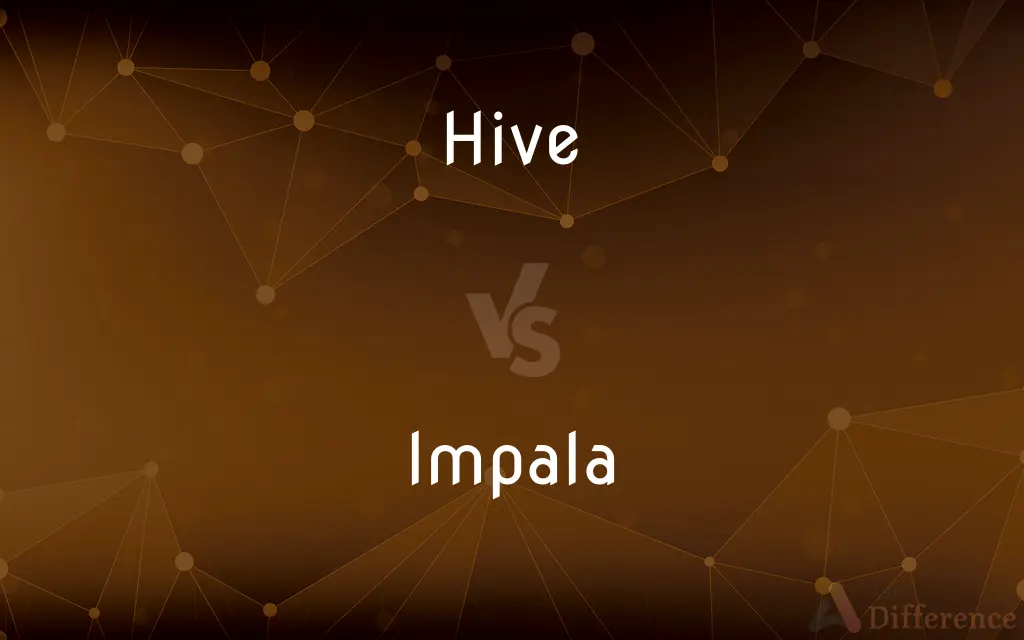Hive vs. Impala — What's the Difference?
Edited by Tayyaba Rehman — By Maham Liaqat — Updated on May 10, 2024
Hive is optimized for batch processing with complex queries, while Impala is designed for low-latency SQL queries, providing faster access to data.

Difference Between Hive and Impala
Table of Contents
ADVERTISEMENT
Key Differences
Hive is a data warehouse infrastructure built on top of Apache Hadoop, designed primarily for batch processing tasks, where the emphasis is on data processing over extensive datasets using complex queries. Whereas, Impala is an open-source, native analytic database for Apache Hadoop, engineered to perform high-speed data querying and real-time analysis.
Hive uses a language called HiveQL, which translates SQL-like queries into MapReduce jobs to execute on Hadoop, making it suitable for managing and querying large datasets that do not require real-time responses. On the other hand, Impala uses the same SQL-like syntax but executes queries natively without translating them into MapReduce jobs, significantly speeding up data retrieval for real-time querying.
Hive's architecture is designed for optimal data warehousing applications with a focus on data integrity and accuracy, utilizing disk-based storage which is more cost-effective for storing large volumes of data. In contrast, Impala is tailored for performance, using in-memory data processing to provide faster query responses, which is ideal for interactive applications.
Hive supports a wide range of data formats and can handle the complexity of different data serialization and deserialization mechanisms, making it highly adaptable for various data integration scenarios. Conversely, Impala emphasizes on speed and is more selective in data format compatibility, optimizing for common formats like Parquet and HDFS to enhance performance.
While Hive is highly extensible, allowing for custom user-defined functions and complex analytical computations which can be crucial for deep data analysis. Impala provides limited extensibility in comparison but compensates with superior performance and ease of use in straightforward data querying tasks.
ADVERTISEMENT
Comparison Chart
Primary Focus
Batch processing
Real-time querying
Query Execution
Converts queries into MapReduce
Direct execution on Hadoop
Performance
Slower, suitable for complex jobs
Fast, suitable for quick lookups
Data Integrity
High, with ACID transactions
Lower, best-effort consistency
Use Case
Data warehousing and analytics
Interactive dashboards and explorations
Compare with Definitions
Hive
Adaptable to various data formats.
Hive works seamlessly with data stored in formats like JSON, Parquet, and ORC.
Impala
Not as extensible as Hive.
While Impala is fast and easy to use, it offers limited options for customization.
Hive
Utilizes disk-based storage.
Hive stores data on disks making it cost-effective for large data sets.
Impala
Lower data integrity but faster responses.
Impala prioritizes speed over transactional integrity.
Hive
Extensible with custom functions.
Users can extend Hive's capabilities by writing their own user-defined functions for complex analyses.
Impala
Real-time query engine for Hadoop.
Impala allows for immediate insights with its real-time processing capabilities.
Hive
Supports SQL-like queries through HiveQL.
HiveQL allows users to perform SQL-like operations on big data.
Impala
Limited data format support for optimized performance.
Impala performs best with optimized formats like Parquet.
Hive
Data warehousing solution built on Hadoop.
Companies use Hive for comprehensive data analysis and reporting.
Impala
Utilizes in-memory data processing.
For faster access, Impala processes data stored in memory.
Hive
A structure for housing domesticated honeybees.
Impala
The impala (, Aepyceros melampus) is a medium-sized antelope found in eastern and southern Africa. The sole member of the genus Aepyceros, it was first described to European audiences by German zoologist Hinrich Lichtenstein in 1812.
Hive
A nest built by wild or feral bees.
Impala
A graceful antelope often seen in large herds in open woodland in southern and East Africa.
Hive
A colony of bees living in such a structure or nest.
Impala
A reddish-brown African antelope (Aepyceros melampus) that has long, curved horns in the male and is noted for its ability to leap.
Hive
A place swarming with activity.
Impala
An African antelope, Aepyceros melampus, noted for its leaping ability; the male has ridged, curved horns.
Hive
To collect into a hive.
Impala
An antelope (Aepyceros melampus) of Southeastern Africa, the male of which has ringed lyre-shaped horns, which curve first backward, then sideways, then upwards. ALso called impalla and pallah.
Hive
To store (honey) in a hive.
Impala
African antelope with ridged curved horns; moves with enormous leaps
Hive
To store up; accumulate.
Hive
To enter and occupy a beehive.
Hive
To live with many others in close association.
Hive
A structure, whether artificial or natural, for housing a swarm of honeybees.
Hive
The bees of one hive; a swarm of bees.
Hive
A place swarming with busy occupants; a crowd.
Hive
A section of the registry.
Hive
(transitive)
Hive
To collect (bees) into a hive.
To hive a swarm of bees
Hive
To store (something other than bees) in, or as if in, a hive.
Hive
(intransitive)
Hive
To form a hive-like entity.
Hive
To take lodging or shelter together; to reside in a collective body.
Hive
(entomology) Of insects: to enter or possess a hive.
Hive
A box, basket, or other structure, for the reception and habitation of a swarm of honeybees.
Hive
The bees of one hive; a swarm of bees.
Hive
A place swarming with busy occupants; a crowd.
The hive of Roman liars.
Hive
To collect into a hive; to place in, or cause to enter, a hive; as, to hive a swarm of bees.
Hive
To store up in a hive, as honey; hence, to gather and accumulate for future need; to lay up in store.
Hiving wisdom with each studious year.
Hive
To take shelter or lodgings together; to reside in a collective body.
Hive
A teeming multitude
Hive
A man-made receptacle that houses a swarm of bees
Hive
A structure that provides a natural habitation for bees; as in a hollow tree
Hive
Store, like bees;
Bees hive honey and pollen
He hived lots of information
Hive
Move together in a hive or as if in a hive;
The bee swarms are hiving
Hive
Gather into a hive;
The beekeeper hived the swarm
Common Curiosities
Can Impala handle complex data processing as well as Hive?
Impala is less suited for complex data processing compared to Hive, which can handle diverse and complex queries.
What is the main advantage of using Hive over Impala?
Hive is better for complex, batch processing jobs where data integrity is crucial.
Which is more suitable for real-time analytics, Hive or Impala?
Impala is designed for real-time analytics with faster query responses.
Is Hive or Impala easier to scale in a large enterprise setting?
Both are scalable; however, Hive's batch processing capabilities might be better suited for large-scale data warehousing needs.
How does the performance of Hive and Impala compare?
Impala is significantly faster for querying than Hive, which is optimized for batch processing.
How do Hive and Impala handle data storage?
Hive uses disk-based storage while Impala primarily uses in-memory storage for speed.
Which system provides better data integrity, Hive or Impala?
Hive offers better data integrity with support for ACID transactions.
Can Impala use HiveQL for queries?
Yes, Impala can execute most HiveQL queries, allowing for easy integration within Hadoop environments.
What type of companies would benefit from using Impala?
Companies needing quick data insights and those using interactive data explorations would benefit from Impala.
What type of query optimization does Impala offer?
Impala offers query optimizations that leverage in-memory computing for rapid data access.
What makes Hive more adaptable to various data formats than Impala?
Hive supports a wider range of data formats and complex data serialization mechanisms.
Can Hive be used for real-time data querying?
Hive is not typically used for real-time querying due to its slower data processing speed.
Does Impala support user-defined functions like Hive?
Impala supports some user-defined functions but is not as extensible as Hive in this regard.
What is the typical use case for Hive in industries?
Industries use Hive for data warehousing, complex querying, and data analysis over large data sets.
Can both Hive and Impala be used together?
Yes, they can be integrated within the same Hadoop ecosystem to leverage both batch and real-time processing.
Share Your Discovery

Previous Comparison
Happiness vs. Satisfaction
Next Comparison
Manager vs. ManageressAuthor Spotlight
Written by
Maham LiaqatEdited by
Tayyaba RehmanTayyaba Rehman is a distinguished writer, currently serving as a primary contributor to askdifference.com. As a researcher in semantics and etymology, Tayyaba's passion for the complexity of languages and their distinctions has found a perfect home on the platform. Tayyaba delves into the intricacies of language, distinguishing between commonly confused words and phrases, thereby providing clarity for readers worldwide.
















































